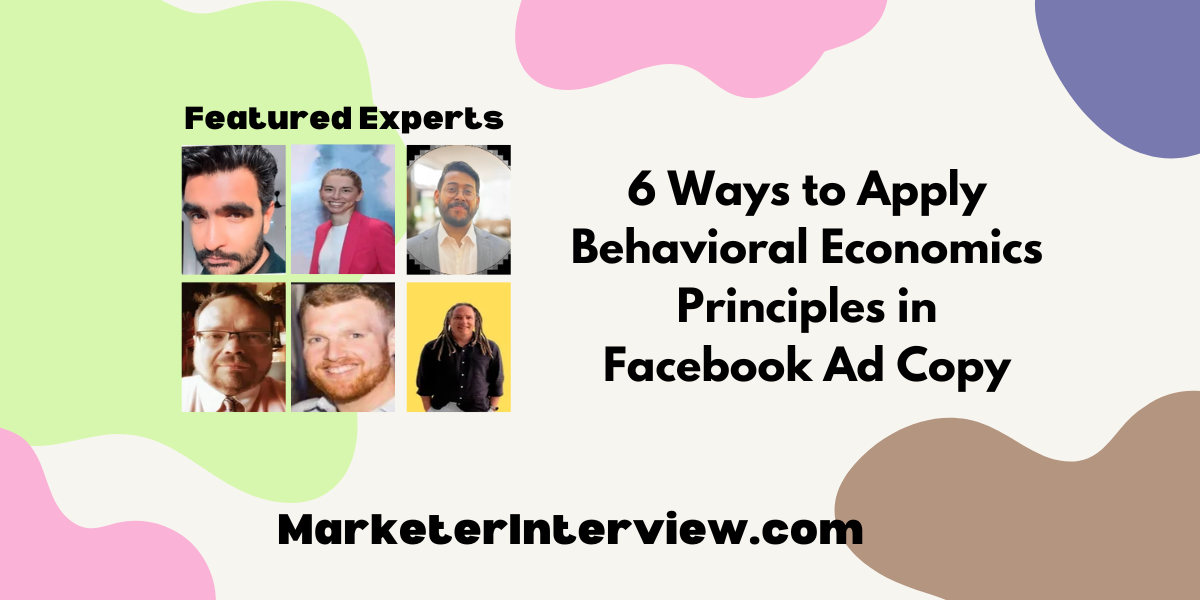6 Ways to Apply Behavioral Economics Principles in Facebook Ad Copy
Delving into the psychology of consumer behavior, we’ve gathered six actionable tips from marketing experts and business leaders on utilizing behavioral economics in your Facebook ad copy. From the Head of Social Media and Communications’ advice to embrace imperfection with the Pratfall Effect to a Founder’s strategy to address objections in ad copy, these insights are tailored to make your social advertising more persuasive and effective.
Want to get quoted in MarketerInterview.com content just like this? Apply to become a contributor today!
Contents
Embrace Imperfection with Pratfall Effect
The Pratfall Effect that I follow while writing Facebook ad copies teaches us that showing imperfections can make you more likable. As an expert, it’s tempting to appear perfect, but sharing small mistakes or funny stories actually builds a stronger connection with your audience.
We can apply the Pratfall Effect by sharing stories where we’ve learned from mistakes to show authenticity. We can add humor when talking about errors—it keeps things light and helps us connect with our audience. By embracing the Pratfall Effect, you humanize your brand and create deeper connections with your audience, leading to stronger engagement and loyalty over time.

Panth Mehta, Head of Social Media and Communications
Create Urgency with Limited-Time Offers
One effective technique I use for my e-commerce clients is leveraging the principle of loss aversion by incorporating limited-time offers in the Facebook ad copy. Highlighting a time-sensitive deal creates a sense of urgency that compels potential buyers to act quickly to avoid missing out.
A few examples that work well for my clients are: “Only 24 Hours Left to Save 20%!” or “Limited Stock Remaining!” By focusing on the limited availability of the discount and the number of people who have already purchased the product, you tap into the consumer’s fear of missing out, significantly increasing conversion rates.

Nayan Prakash, PPC Manager
Increase Engagement with Reciprocity and Scarcity
One technique I frequently use in Facebook ad copy involves leveraging the “reciprocity” principle. During a campaign for a SaaS product, we offered a free, high-value eBook titled “10 Ways to Streamline Your Business Operations.” Phrases like “Download your free guide today!” created a sense of obligation in users, leading to a 30% increase in lead generation. This act of giving something valuable upfront made users more likely to reciprocate by engaging further with our product.
I also found the “scarcity” principle highly effective. For an e-commerce client, we ran a campaign featuring limited-time offers with ad copy saying, “Only 10 items left—don’t miss out!” This approach capitalized on the fear of missing out (FOMO), resulting in a 25% boost in purchases. Creating a sense of urgency motivated viewers to take immediate action, significantly elevating the perceived value and attractiveness of the product.
Additionally, the “social proof” principle has proven beneficial. In a campaign for a local restaurant, we showcased customer testimonials and ratings within the ad, such as “Rated 4.8 stars by over 1,000 happy diners!” This strategy increased reservations by 30% because people tend to trust and follow the actions of others, especially when they see positive feedback. Integrating social proof adds credibility and reassures potential customers of the value of the offering.

Haiko de Poel, Owner, Mass Impact
Present Solutions to Problems
The core principle we try to implement with our Facebook ads is to identify a problem, then present a solution. In our line of work, this means focusing on things like transparent pricing (a solution to hidden fees), personal, friendly service (a solution to wondering whom to trust with your belongings), and easy booking options (a solution to confusing online reservations).

Nick Valentino, VP of Market Operations, Bellhop
Enhance Credibility with Authority
I’ve found that applying the principle of “authority” can significantly enhance the effectiveness of Facebook ad copy. Authority suggests that people are more likely to be influenced by individuals or entities perceived as experts. For example, in a campaign for a fitness studio, we included endorsements from certified trainers and fitness experts. We used copy like “Recommended by top fitness coaches” and showcased their credentials. This approach led to a 30% increase in trial sign-ups, as the perceived expertise boosted credibility.
A concrete example of leveraging “social norms” comes from a campaign for a boutique fitness studio. We highlighted how many local residents had already joined our classes by using phrases such as “Join the 1,000+ members who have transformed their lives with us.” This tactic taps into the idea that if a large number of people are doing something, others are more likely to follow. This effort resulted in a 35% increase in class registrations, showcasing the power of social conformity.
Another impactful strategy is utilizing “anchoring.” In an e-commerce campaign, we displayed a higher-priced item first to establish a price reference point. Following this, the lower-priced items seemed like a much better deal. For a campaign with mid-range kitchen appliances, this method resulted in a 22% increase in sales of the mid-range product. The initial high anchor price made the subsequent options appear more attractive and affordable. This principle of setting a reference point helps steer consumer perception and decision-making.

Matt Henderson, Co-Owner, Nesta System LLC
Address Objections in Ad Copy
The best ad is when it doesn’t feel like an ad. No one wants to be sold to or marketed to. So typically, when it comes to ads, you have to deal with a range of objections your prospective customers have in mind when they see your ad. You see those objections in the comments under the ads.
The best way to deal with it is to handle these objections upfront.
Here’s my top 3 most common objections:
1. Financial – they think it’s too expensive. Emphasize and illustrate the value and return on investment of your product or service. Use words like: maximize, elevate, affordable. Focus on cost-effectiveness and long-term benefits.
2. Trust – there is always skepticism around reliability and effectiveness; that’s why reviews are the #1 decision-making factor for purchase. Showcase testimonials, proven results, the number of users to date, geographical presence. Showcase anything that can serve as evidence for tangible results. Highlight the user community and continuous support for onboarding and guidance.
3. Routine Disruption and Risk – anxiety over trying something new and breaking the habit is bigger than we think. Address it by showcasing how your product or service easily integrates into your daily routine with minimum distraction. Offer free trials and money-back guarantees.
When thinking of copy itself, make sure it’s easy to read, use bullet points, and extra space between the lines.

Anna Khomenko, Founder, Startup Dials
Want to get quoted in MarketerInterview.com content just like this? Apply to become a contributor today!






